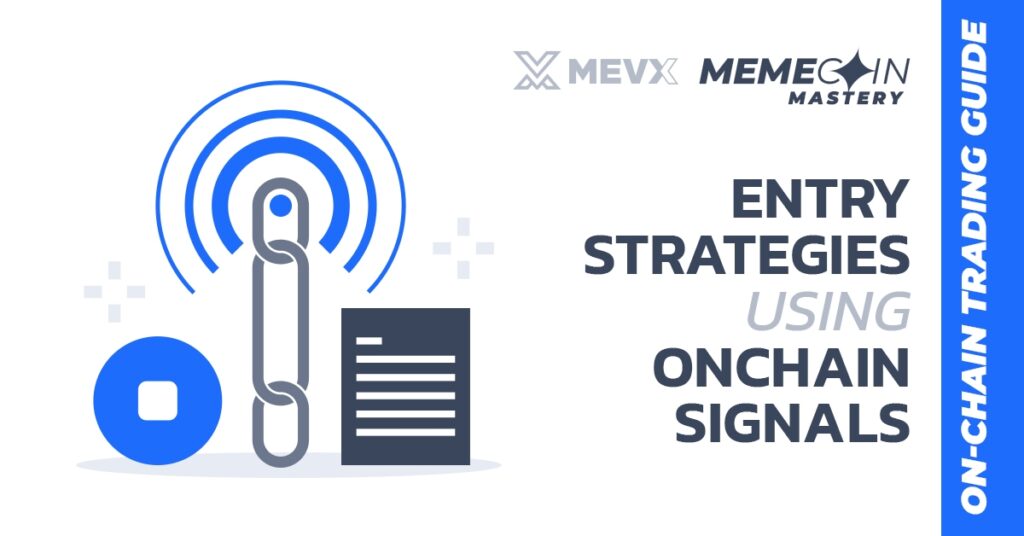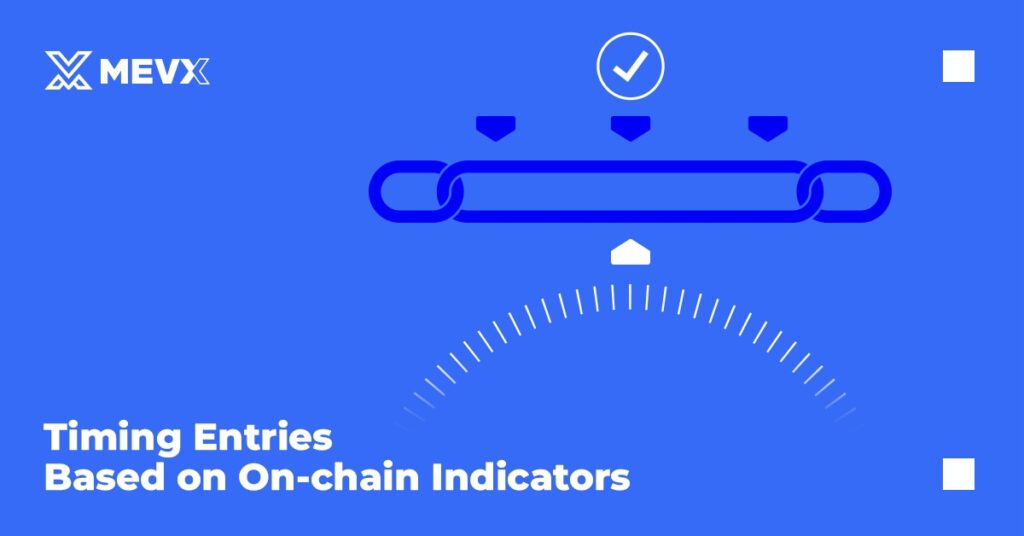Successful meme coin trading depends heavily on entry timing and positioning. While traditional technical analysis focuses on price patterns, on-chain signals provide earlier and more reliable entry indicators by revealing underlying market dynamics before they manifest in price action.

This guide explores how to systematically identify and execute optimal entry strategies using blockchain data.
On-chain Signals – Foundation of Entry Strategies
On-chain signals offer unique advantages over price-based indicators because they reveal actual market participant behavior rather than just price outcomes. These signals typically precede price movements by hours or days, providing superior entry timing opportunities for prepared traders.
The most effective entry strategies combine multiple on-chain signals to create high-confidence entry points while maintaining strict risk management protocols. Single-signal entries often produce false positives, but multi-signal confirmation systems significantly improve success rates and risk-adjusted returns.
Multi-Signal Confirmation Systems
Primary Signal Categories
- Liquidity Flow Analysis: Monitor changes in liquidity depth and distribution across different price levels.
- Whale Accumulation Patterns: Track large wallet accumulation phases through transaction size analysis and holding period calculations.
- Transaction Velocity Changes: Measure changes in transaction frequency and average transaction sizes.

Secondary Confirmation Signals
- Social Sentiment Alignment: Verify that on-chain accumulation patterns align with improving social sentiment metrics. The strongest entries occur when positive on-chain activity coincides with organic social media growth.
- Developer Activity Indicators: Monitor development team wallet activity and project update frequency. Increased team engagement often precedes marketing pushes and community growth phases.
- Cross-Token Correlation: Analyze how similar tokens are performing and whether broader meme coin sector trends support individual token opportunities.
Timing Entry Strategies Based on On-chain Indicators
Accumulation Phase Identification
- Early Accumulation Detection: Identify tokens showing increasing holder counts with stable or slightly declining prices. This pattern often indicates smart money accumulation before broader market recognition.
- Distribution Analysis Evolution: Monitor changes in token distribution metrics over time.
- Liquidity Growth Correlation: Look for tokens where liquidity provision grows faster than price appreciation, indicating sustainable growth foundations rather than speculative bubbles.

Momentum Transition Points
- Volume Velocity Acceleration: Identify moments when trading volume accelerates while maintaining healthy transaction size distributions.
- Social Signal Integration: Time entries when on-chain accumulation patterns begin receiving social media attention, but before mainstream influencer involvement drives prices to unsustainable levels.
- Market Maker Engagement: Monitor when market makers begin providing deeper liquidity, indicating institutional confidence in token potential and improved trading conditions.
Risk Assessment Integration
Onchain Risk Metrics
- Concentration Risk Analysis: Calculate position sizes based on current holder concentration levels. Higher concentration requires smaller position sizes and tighter stop-losses.
- Liquidity Depth Assessment: Evaluate whether current liquidity levels can support your intended position size without excessive price impact.
- Contract Security Verification: Ensure thorough contract analysis completion before entry, including verification of renounced ownership, locked liquidity, and absence of malicious functions.
Dynamic Risk Adjustment
- Market Condition Correlation: Adjust entry criteria based on broader market conditions. During high volatility periods, require stronger confirmation signals before entering positions.
- Competitive Analysis: Consider current bot activity levels and MEV extraction potential when sizing positions. High automation levels may require smaller initial positions with scaling strategies.
- Portfolio Correlation Management: Ensure new entries don’t create excessive correlation with existing positions, maintaining diversification even within meme coin allocations.
Position Sizing Based on On-chain Metrics
Signal Strength Correlation
- High-Confidence Entries: When multiple strong on-chain signals align with positive social sentiment, consider larger initial position sizes while maintaining overall portfolio risk limits.
- Moderate-Confidence Opportunities: For single-signal or weaker multi-signal entries, use smaller initial positions with plans to scale if confirmation signals develop.
- Exploratory Positions: For early-stage opportunities with limited signal confirmation, use minimal position sizes that allow for significant scaling if opportunities develop favorably.

Liquidity-Based Sizing
- Maximum Position Calculations: Limit position sizes to ensure exit capability within acceptable slippage parameters, typically no more than 2-5% of available liquidity, depending on volatility levels.
- Scaling Protocol Development: Establish systematic approaches for increasing position sizes as liquidity and signal confirmation improve, while maintaining risk management discipline.
- Emergency Exit Planning: Ensure all positions remain small enough to exit quickly during emergency situations, considering potential liquidity reductions during stress periods.
Advanced Entry Techniques
Staged Entry Strategies
- Progressive Accumulation: Develop systematic approaches for building positions over time as confirmation signals strengthen, rather than committing full intended position sizes immediately.
- Volatility-Based Timing: Use short-term volatility spikes to improve entry prices while maintaining strategic timing based on longer-term on-chain signals.
- Liquidity Event Coordination: Time entries around liquidity addition events or major developments that may improve trading conditions and signal strength.
Cross-Platform Optimization
- Multi-DEX Analysis: Monitor multiple DEXs simultaneously to identify optimal entry platforms based on liquidity depth, transaction costs, and MEV activity levels.
- Aggregator Utilization: Use DEX aggregators strategically to optimize entry prices while considering potential MEV exposure and transaction costs.
- Private Pool Access: When available, utilize private transaction pools to reduce MEV extraction and improve entry execution quality.
Entry Execution Optimization
Transaction Timing
- Gas Fee Management: Time entries during periods of lower network congestion to minimize transaction costs while maintaining signal-based timing requirements.
- Block Priority Strategy: Use appropriate priority fees to ensure transaction execution without overpaying for unnecessary speed when signal timing allows flexibility.
- Slippage Optimization: Balance slippage tolerance with entry price optimization, considering current market conditions and liquidity depth.
Order Strategy Selection
- Market vs. Limit Orders: Choose between market orders for immediate execution and limit orders for price optimization based on signal urgency and market conditions.
- Order Splitting Techniques: Split large entries across multiple transactions to reduce price impact and MEV extraction while maintaining strategic timing.
- Contingency Planning: Prepare backup execution strategies for situations where primary entry methods fail due to network congestion or liquidity changes.
How to Build Your Entry System
Signal Monitoring Infrastructure
- Real-Time Analysis Platforms: Implement monitoring systems that track multiple on-chain signals simultaneously and provide integrated analysis for entry decision-making.
- Alert System Design: Create alert systems that notify you when multiple entry signals align, providing timely opportunity identification without constant manual monitoring.
- Historical Performance Tracking: Maintain records of entry decisions and outcomes to continuously improve signal interpretation and timing strategies.
Decision Framework Development
- Entry Criteria Checklists: Develop systematic checklists that ensure consistent evaluation of all relevant factors before making entry decisions.
- Risk-Reward Calculations: Establish standardized methods for calculating risk-reward ratios based on on-chain signal strength and market conditions.
- Review and Adaptation Protocols: Regularly review entry performance and adapt strategies based on changing market conditions and signal effectiveness.
Integration with Overall Trading Strategy
Portfolio Management Connection
- Sector Allocation Limits: Ensure entry strategies support overall portfolio diversification goals and don’t create excessive concentration in similar opportunities.
- Risk Budget Management: Integrate entry decisions with broader portfolio risk management to maintain appropriate overall exposure levels.
- Performance Attribution: Track how entry timing contributes to overall trading performance to identify areas for improvement and successful patterns to replicate.
Long-Term Strategy Alignment
- Market Cycle Awareness: Adapt entry strategies based on current market cycle phases and expected evolution of meme coin sector dynamics.
- Skill Development Planning: Focus entry strategy development on areas that provide sustainable competitive advantages as markets become more sophisticated.
- Technology Integration: Continuously evaluate new tools and techniques that can improve entry signal identification and execution quality.
Mastering optimal entry strategies requires balancing systematic signal analysis with tactical execution flexibility. The goal is to develop consistent approaches that capitalize on on-chain trading insights while maintaining the adaptability necessary for dynamic meme coin markets.
Remember that even the best entry strategies cannot guarantee profits, but they significantly improve the probability of favorable outcomes while providing structured approaches for managing the inevitable losses that accompany active trading.
Follow our MevX blog for more updated guides on meme coin trading.
Share on Social Media:
